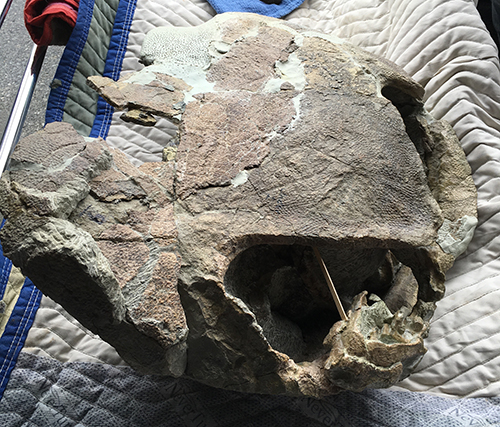Specimen now on display in new exhibit
[July 11, 2016; Kennett Square, PA] – At the request of scientists at the New Jersey State Museum, veterinarians at Penn Vet’s New Bolton Center used a new robotics-controlled imaging system to scan an exceedingly rare turtle fossil, estimated at about 65 million years old.
The Cretaceous specimen is now on display as part of a new Natural History Hall exhibit, “Written in the Rocks,” which opened July 2 at the museum in Trenton.

A museum research associate contacted New Bolton Center’s Dr. Dean Richardson to ask if the new imaging system could possibly be used to see the bones inside the turtle fossil. Richardson set up the scan for June 16, free of charge.
Typical imaging equipment could not accommodate the large turtle fossil, but New Bolton Center’s revolutionary system is designed with robotic arms that move around the patient, allowing examination of the entire anatomy of horses and other large animals.
Penn Vet is the first veterinary teaching hospital in the world using the
EQUIMAGINE™ imaging system, which has clinical and research applications for both animal and human medicine. In collaboration with Four Dimensional Digital Imaging (4DDI), the company behind the system’s innovation, New Bolton Center veterinarians are developing application-related protocols for large animals.
The computed tomography (CT) scan of the 200-pound fossil only took only about 30 seconds, the two robotic arms moving around the specimen. The 190-degree, 3-D images show the outside of the turtle, with great detail of the head and the hands. Only one bone inside is visible, the humerus.
“We can see the position of the head and neck, how it is tucked underneath the shell. We can also make out individual neck bones,” said Dr. Chris Ryan, the New Bolton Center radiologist, who had never before scanned a fossil.
“We were curious to see if we could see anything inside the fossilized shell, but it was all just dense rock,” he said. “The most we could see inside was a little bit of the upper arm bone.”
For a CT scan to be successful, there must be differences in the densities of materials. But the inside of the turtle was uniform, the biological materials replaced with minerals over time.
The turtle is of the type with the genus name Basilemys. Appropriately, the scientists have named it Basil. They found it in Carbon County, Montana, during the Bighorn Basin Dinosaur Project’s 2013 Field Expedition.
More than a year’s worth of meticulous work with tiny air-powered jackhammers in the Paleo Lab at the Academy of Natural Sciences of Drexel University, slowly chipped away the hardened iron carbonate mineral stone, revealing a nearly complete turtle.
“It turned out to be the best fossil we’ve found yet. Fossils are very rarely found complete,” said Jason Schein, the museum’s Assistant Curator of Natural History. “To find such a large percentage of a skeleton, and to find a skeleton that is so perfectly articulated, that it looks like it died yesterday, is very, very rare.”
Also rare is that the turtle is clearly demonstrating some kind of behavior. “When a turtle gets stressed it tucks in its head and pulls its arms in, and that is what this turtle is doing. That is what happened when he died, when he got buried.
“We do a lot of interpreting of behavior, but it is not often that we see behavior,” Schein continued. “There is something special about seeing that last moment of the animal’s life so long ago.”
The fossil is dated to 65 million to 67 million years ago, around the time that dinosaurs went extinct. According to Schein, the fossil may be one of the most complete examples of this species anyone has ever seen.
The turtle will be in a case so museum visitors can walk around and view it from all angles. Eventually the scans from New Bolton Center may be incorporated into the display.
For more information, please read our
Penn Vet Extra story.
Photos are available on Penn Vet’s
Flickr page.
About the New Jersey State Museum
As a center of cultural, educational and scientific engagement, the New Jersey State Museum, a division of the New Jersey Department of State, inspires innovation and lifelong learning through its collections, research, exhibitions and programs in science, history and art. The Museum engages visitors of all ages and diverse backgrounds in an exploration of New Jersey’s cultural and natural history presented within a global context, fosters state pride and serves as a cultivator of tomorrow’s leaders.
Located at 205 West State Street in Trenton, the Museum is open Tuesday through Sunday from 9 am to 4:45 pm. The Museum is closed Mondays and all state holidays. The Museum has a suggested admission fee of $5 for adults and $4 for seniors and students with valid ID; children 12 and under are free. Admission fee revenue supports the Museum’s collections, exhibitions and programs.
For more information, visit www.statemuseum.nj.gov.